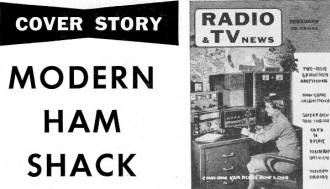Cover Story: Modern Ham Shack |
||
World Radio Laboratories (WRL) was a major manufacturer of amateur radio equipment in the middle of the last century. They were famous for high power transmitters like the Globe King models, which looked exactly like the big, black, rack-based units seen in older movies with Ham radio cameos. It took a couple chassis filled with big glowing vacuum tubes to pump out a kilowatt of power. Today's semiconductor-based transmitters do the job in a small fraction of the volume, with higher quality and higher reliability and with usually no periodic maintenance required. The savings in your electric bill is substantial. WRL provided a great service to the amateur radio community that constituted its customer base by encouraging anyone passing through Council Bluffs, Iowa, to stop in and use its well-equipped Ham shack. The place was kind of a Midwest version of the American Radio Relay League's (ARRL) W1AW facility at their Connecticut headquarters. It was so popular that it made the cover of the February 1958 issue of Radio & TV News magazine. Cover Story: Modern Ham Shack
The girl on our cover this month is Dorothy Hicks, K0BRZ, who lives in Omaha, Nebraska. Dorothy is shown operating at WRL's demonstration ham shack in Council Bluffs, Iowa. Although she would eventually like to have a home setup that is as elaborate as the one shown, Dorothy's home station is a little more modest-a Johnson Viking "Ranger," a WRL tri-band beam, and a National NC-300 receiver. She does most of her rag-chewing, usually about 3 hours' worth a day, on 10- and 15-meter phone. Dorothy really comes from a hamming family. Her husband, Curt Hicks, is K0AMM. He is president of the Ak-Sar-Ben Radio Club and is very active in local Civil Defense affairs. Much of his hamming is with a mobile rig consisting of a 10-meter Subraco transmitter and a PMR-6 Multi-Elmac receiver. Paul, one of their two sons, received his Novice ticket when he was 11. His call is KN0GZJ. Dorothy took her Novice and General Class training at World Radio Laboratories' code classes. Her son was also trained here. Novice training has been going on for the past several years. During last year, approximately 300 received their licenses and Leo Meyerson, head of WRL, expects that almost double this number will receive their licenses this year. As a matter of fact, the last group of trainees (some 86 in number) was so large that the group had to meet at one of the local schools for adequate room. The ham shack shown on our cover has been set up for the convenience of customers who wish to keep a schedule while passing through or simply for them to keep up on their hobby by seeing and using the latest ham gear. Equipment is changed regularly so that over a period of a year, just a bout every manufacturer is represented. The ham shack is in operation for about two hours a day and it is also available to Novice operators who don't as yet have their own stations. Equipment Used In the setup shown, Dorothy is speaking into an Astatic D-104 crystal mike which is connected to the Hallicrafters HT-32 transmitter (center unit on desk). A Vibroplex bug is nearby for c.w. operation. The transmitter is being used here as a single-side-band exciter with its output suitably reduced by a power reducer network and applied to the r.f. section of the WRL "Globe King" 500B transmitter (at right). The power of this transmitter under single-sideband conditions is 720 watts peak envelope power input to the final. Since the 500B also contains its own exciter, v.f.o., and speech modulator sections, this unit may be used independent of the separate exciter shown here. As such, the "Globe King" may be used as a complete phone and c.w. transmitter with bandswitching provided from 10 through 160 meters. The plate power input is 540 watts on either phone or c.w. The HT-32 exciter may also be used as a completely separate and independent lower power standby transmitter. This unit provides single-sideband, phone, or c.w. operation from 80 through 10 meters. The peak envelope power input is 144 watts. The output of the high-power rig is fed to a high-gain 20-meter beam through an external antenna relay. Atop the exciter unit are two loudspeakers which are connected to the two receivers at the left. The upper receiver is the Hammarlund HQ-110, a twelve-tube superhet with dual conversion. Full-dial coverage of the 6- to 160-meter amateur bands is provided. The receiver provides an Auto-Response feature that lowers the audio passband as the audio gain is increased. Thus the response to strong signals is bread. band and to weak signals is narrow band. Other features include crystal-controlled second conversion oscillator, Q-multiplier, crystal calibrator, and separate linear detector for SSB. The bottom receiver is the National NC-109, an eleven-tube general coverage unit tunable from 540 kc. to 40 mc. in four bands. A separate product detector is used for SSB and c.w. reception. A gang-tuned r.f. amplifier stage, plus two i.f. and two audio stages are used. The idea of using a pair of receivers is so that a continuous civil defense monitor system can be employed. In this case then, the Hammarlund HQ-110 may be used as the amateur band receiver while the National NC-109 may be used as the monitoring receiver. Tacked onto the wall behind the equipment are some of the large number of QSL cards from hams that have been worked from the station. Other cards are from the many hams who have just dropped in to operate the station or to say "hello." (Cover Photo by G. C. Lucas)
Posted January 15, 2020 |
||

